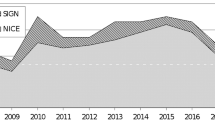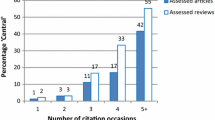Abstract
Background The Journal Citation Reports (JCR) Pharmacology and Pharmacy subject category is heterogeneous. The inclusion of journals with basic and clinical scopes, which have different citation patterns, compromises comparability of impact factors among journals within the category. Objective To subdivide the Pharmacology and Pharmacy category into basic pharmacology, clinical pharmacology, and pharmacy based on the analyses of Medical Subject Headings (MeSH) as a proxy of journals’ scopes. Setting JCR. Method All articles, and respective MeSH, published in 2013, 2014, and 2015 in all journals included in the 2014 JCR Pharmacology and Pharmacy category were retrieved from PubMed. Several models using a combination of the 14 MeSH categories and specific MeSH tree branches were tested using hierarchical cluster analysis. Main outcome measure Distribution of journals across the subcategories of the JCR Pharmacology and Pharmacy subject category. Results A total of 107,847 articles from 214 journals were included. Nine different models combining the MeSH categories M (Persons) and N (Health Care) with specific MeSH tree branches (selected ad-hoc) and Pharmacy-specific MeSH (identified in previous research) consistently grouped 142 journals (66.4%) in homogeneous groups reflecting their basic and clinical pharmacology, and pharmacy scopes. Ultimately, journals were clustered into: 150 in basic pharmacology, 43 in clinical pharmacology, 16 in basic pharmacology and clinical pharmacology, and 5 in pharmacy. Conclusion The reformulation of the Pharmacology and Pharmacy category into three categories was demonstrated by the consistent results obtained from testing nine different clustering models using the MeSH terms assigned to their articles.

Similar content being viewed by others
References
Web of Science. The Thomson Reuters Impact Factor. http://wokinfo.com/essays/impact-factor/. Accessed October 24, 2016.
Lippi G. The impact factor for evaluating scientists: the good, the bad and the ugly. Clin Chem Lab Med. 2009;47:1585–6.
Seglen PO. Why the impact factor of journals should not be used for evaluating research. BMJ. 1997;314:498–502.
The Monatstersky R, Science Number That’s Devouring. Chronicle of Higher Education. 2005;52:A12.
Not-so-deep impact. Nature. 2005;435:1003-4.
van Leeuwen T. Discussing some basic critique on Journal Impact Factors: revision of earlier comments. Scientometrics. 2012;92:443–55.
Fernandez-Llimos F. Bradford’s law, the long tail principle, and transparency in Journal Impact Factor calculations. Pharm Pract (Granada). 2016;14:842.
Dorta-Gonzalez P, Dorta-Gonzalez MI. Comparing journals from different fields of science and social science through a JCR subject categories normalized impact factor. Scientometrics. 2013;95:645–72.
Waltman L, van Eck NJ, van Leeuwen TN, Visser MS, van Raan AFJ. Towards a new crown indicator: an empirical analysis. Scientometrics. 2011;87:467–81.
Morillo F, Bordons M, Gomez I. Interdisciplinarity in science: a tentative typology of disciplines and research areas. J Am Soc Inf Sci Tec. 2003;54:1237–49.
Pudovkin AI, Garfield E. Algorithmic procedure for finding semantically related journals. J Am Soc Inf Sci Tec. 2002;53:1113–9.
Silcox B, Makar S, Ouimette M. Technology Services Reports: analysis of the Journal of Research of the National Institute of Standards and Technology: National Institute of Standards and Technology 2005.
Thomson Reuters. Web of Science. www.webofknowledge.com. Accessed September 12, 2016.
Intellectual Property & Science. Scope Notes 2012 Science Citation Index Expanded. http://ip-science.thomsonreuters.com/mjl/scope/scope_scie/. Accessed October 24, 2016.
van Eck NJ, Waltman L, van Raan AF, Klautz RJ, Peul WC. Citation analysis may severely underestimate the impact of clinical research as compared to basic research. PLoS ONE. 2013;8:e62395.
Narin F, Hamilton KS. Bibliometric performance measures. Scientometrics. 1996;6:293–310.
Seglen PO. Bruk av siteringsanalyse og andre bibliometriske metoder i evaluering av forskningsaktivitet. Tidsskr Nor Laegeforen. 1989;31:3229–34.
Narin F, Pinski G, Gee HH. Structure of the biomedical literature. J Am Soc Inform Sci. 1976;27:25–45.
Folly G, Hajtman B, Nagy JI, Ruff I. Some methodological problems in ranking scientists by citation analysis. Scientometrics. 1981;3:135–47.
Research Assessment. Journal Citation Ranking and Quartile Scores. https://researchassessment.fbk.eu/quartile_score. Accessed November 18, 2016.
Minguet F, Salgado TM, van den Boogerd L, Fernandez-Llimos F. Quality of pharmacy-specific Medical Subject Headings (MeSH) assignment in pharmacy journals indexed in MEDLINE. Res Social Adm Pharm. 2015;11:686–95.
Price DJ. Networks of Scientific Papers. Science. 1965;149:510–5.
Carpenter MP, Narin F. Clustering of scientific journals. J Am Soc Inform Sci. 1973;24:425–36.
Narin F, Carpenter MP. Clustering of scientific journals. J Am Soc Inform Sci. 1973;24:425–35.
Narin F, Carpenter MP, Berlt N. Interrelationships of scientific journals. J Am Soc Inform Sci. 1972;23:323–31.
Small H, Sweeney E, Greenlee E. Clustering the Science Citation Index using co-citations. II. Mapping science. Scientometrics. 1985;8:321–40.
Rafols I, Leydesdorff L. Content-based and algorithmic classifications of journals: Perspectives on the dynamics of scientific communication and indexer effects. J Am Soc Inf Sci Tec. 2009;60:1823–35.
Schvaneveldt RW, Dearholt DW, Durso FT. Graph theoretic foundations of Pathfinder networks. Comput Math Appl. 1988;15:337–45.
Guerrero-Bote VP, Zapico-Alonso F, Espinosa-Calvo ME, Gomez-Crisostomo R, Moya-Anegón F. Binary Pathfinder: an improvement to the Pathfinder algorithm. Inform Process Manag. 2006;42:1484–90.
Leydesdorf L. The generation of aggregated journal-journal citation maps on the basis of the CD-ROM version of the Science Citation Index. Scientometrics. 1994;31:59–84.
Small H, Sweeney E. Clustering the Science Citation Index® using co-citations. I. A comparison of methods. Scientometrics. 1985;7:391–409.
Moya-Anegón F, Vargas-Quesada B, Herrero-Solana V, Chinchilla-Rodríguez Z, Corera-Álvarez E, Munoz-Fernández FJ. A new technique for building maps of large scientific domains based on the cocitation of classes and categories. Scientometrics. 2004;61:129–45.
Leydesdorf L. Words and co-words as indicators of intellectual organization. Res Policy. 1989;18:209–23.
Callon M, Courtial JP, Turner WA, Bauin S. From translations to problematic networks: an introduction to coword analysis. Social Science Information. 1983;22:191–235.
The National Library of Medicine. Fact sheet: Medical Subject Headings (MeSH®). 2014. http://www.nlm.nih.gov/pubs/factsheets/mesh.html. Accessed December 2, 2013.
Lipscomb CE. Medical Subject Headings (MeSH). Bull Med Libr Assoc. 2000;88:265–6.
Clatworthy J, Buick D, Hankins M, Weinman J, Horne R. The use and reporting of cluster analysis in health psychology: a review. Br J Health Psychol. 2005;10:329–58.
Yim O, Ramdeen KT. Hierarchical Cluster Analysis: Comparison of Three Linkage Measures and Application to Psychological Data. Quant Methods Psychol. 2015;11:8–21.
Minguet F, Van Den Boogerd L, Salgado TM, Correr CJ, Fernandez-Llimos F. Characterization of the Medical Subject Headings thesaurus for pharmacy. Am J Health Syst Pharm. 2014;71:1965–72.
Cohen J. A coefficient of agreement for nominal scales. Educ Psychol Meas. 1960;20:37–46.
The National Library of Medicine. Medical Subject Headings (MeSH®) in MEDLINE®/PubMed®: A Tutorial. https://www.nlm.nih.gov/bsd/disted/meshtutorial/principlesofmedlinesubjectindexing/theindexingprocess/index.html. Accessed November 17, 2016.
Gorraiz J, Schloegl C. A bibliometric analysis of pharmacology and pharmacy journals: Scopus versus Web of Science. J Inf Sci. 2008;34:715–25.
Rodriguez RW. Comparison of indexing times among articles from medical, nursing, and pharmacy journals. Am J Health Syst Pharm. 2016;73:569–75.
U.S. National Library of Medicine. Creating a List of MEDLINE Journals by Subject or Subset. https://www.nlm.nih.gov/services/journalsbysubject.html. Accessed November 29, 2016.
Sanz EJ. Pharmacoepidemiology and the “impact factor”. Eur J Clin Pharmacol. 2005;60:765–72.
Anonymous. The International Catalogue of Scientific Literature. Science. 1895;2:154-7.
Seglen PO. Evaluation of scientific quality using citation analysis and other bibliometric methods. Nord Med. 1989;104(331–5):41.
Drettner B, Seglen PO, Sivertsen G. Inverkanstal som fördelningsinstrument: ej accepterat av tidskrifter i Norden. Läkartidningen. 1994;91:744–5.
Gøtzsche PC, Krog JW, Moustgaard R. Bibliometrisk analyse af dansk sundhedsvidenskabelig forskning 19881992. Ugeskr Laeger. 1995;157:5075–81.
Taubes G. Measure for measure in science. Science. 1993;260:884–6.
Vinkler P. Evaluation of some methods for the relative assessment of scientific publications. Scientometrics. 1986;10:157–77.
Funding
This research did not receive any specific grant from funding agencies in the public, commercial, or not-for-profit sectors.
Conflicts of interest
The authors have no conflicts of interest to disclose.
Author information
Authors and Affiliations
Corresponding author
Electronic supplementary material
Below is the link to the electronic supplementary material.
Rights and permissions
About this article
Cite this article
Minguet, F., Salgado, T.M., Santopadre, C. et al. Redefining the pharmacology and pharmacy subject category in the journal citation reports using medical subject headings (MeSH). Int J Clin Pharm 39, 989–997 (2017). https://doi.org/10.1007/s11096-017-0527-2
Received:
Accepted:
Published:
Issue Date:
DOI: https://doi.org/10.1007/s11096-017-0527-2




